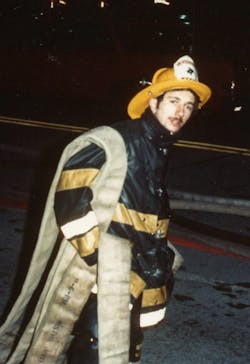I cannot look back at the 40-year history of Firehouse Magazine without also looking back upon myself and the fire service in general. My first published piece, which appeared in the June 1982 issue, was entitled “So You Wanna Be Chief?” It provided a humorous, but truthful account of my first night of command, when less than an hour after taking office, we suffered the largest dollar-loss fire in the history of our community. Thankfully for me, that dubious honor has since been claimed by others, but no one has yet laid claim to catching a working public assembly fire while still in the swearing-in meeting. For all intents and purposes, it was a back step story—something you’d share at the firehouse, so why not IN Firehouse? That first article led to dozens of other articles in subsequent years and working with an ever-changing yet always amazing group of people whose focus was on getting quality information to firefighters around the world.
Back in the early days of the publication, the fire service was a different animal. Municipal departments were surviving the 70s and the chronicled battles with arson and urban decay. For volunteers, the times were changing, as more educated chiefs began to take safety seriously, and wearing breathing apparatus no longer made you less than a “real firefighter.” There were sweeping advances in technologies, trucks and tactics, and Firehouse presented me and fellow authors with the opportunity to report these to our readers.
During the past four decades, I’ve written articles entitled “Big Reels,” “Coming Online – Cellular Mobile Phones,” “The Alarm Box – A Vanishing Breed?” “How the Volunteer Can Respond Safely and Quickly,” ”Using the Internet to Manage Emergencies,” ”911 Since 9/11 – Coping With the New Realities,” “Expanding Expectations – Retreating Resources,” and many, many more. You can see the variety of topics we covered.
Of all these efforts, the article that I enjoyed writing the most was called “That ‘70s Show.” The article, which ran in August 2006, looked back at the firefighting fads, foibles and firsts from the decade that spawned Firehouse Magazine. It was also the decade that introduced me to the fire service, and it was a great pleasure to reminisce and detail those experiences more than 25 years after the fact.
The biggest challenges faced by any correspondent or contributing editor, I think, is to convey a clear message in a compressed amount of space. There are so many factors that influence almost everything we do in the fire service that it is virtually impossible to completely cover every possible nuance and permutation. For that reason, I have always attempted to leave the reader with as many questions as answers. If nothing else, I hopefully have provided them with guidance to a path that will lead to more research, discussion and, ultimately, a successful solution. Of course, I believe that our collective primary goal as authors and influencers is to make firefighters smarter and safer. I’m a back-step-riding, canvas-gear wearing, leather lunged relic of tradition who is still around largely because I learned to do things a better way. It’s a real quick trip from rookie to elder statesman, yet too many of us fail to make it. That’s why pieces I’ve written about finding easier and safer ways to do things are especially important to me.
However, in order to inform an audience, you have to reach an audience, and so it’s always necessary to have fresh and topical ideas, and formats that welcome the reader in. That’s what’s kept Firehouse in the forefront of public safety journals for the past four decades, and it is something that I think about frequently. Keep in mind that many of my contributions cover the field of technology and communications. Compared to other content, the subject isn’t sexy. I don’t usually report on major toxic spills or dramatic rescues. My illustrations do not normally feature shiny apparatus with chrome wheels and flashing lights. But I do talk about devices that help speed access to our services, are used on each and every run, and that conceivably can save your life. As someone who has spent significant time on both sides of the microphone as a fire chief and as a communications director, I think this is pretty important stuff. My job is to convince you to think so, too.
Coming from a family where dad was a firefighter and mom was a writer, I hope my work in Firehouse has made them both proud. Maybe my son and daughter will someday carry on the tradition. My most fervent wish is that sometime, something I said was somehow helpful to somebody, somewhere. Happy 40th Anniversary, Firehouse!
About the Author

Barry Furey
BARRY FUREY, who is a Firehouse Contributing Editor, provides consulting and training services in emergency communications. He is the former director of the Raleigh-Wake Emergency Communications Center in North Carolina. During his 50-year public safety career, he has managed 9-1-1 centers and served as a volunteer fire officer in three other states. In 2005, Furey received a life membership in the Association of Public-Safety Communications Officials (APCO) International for his continued work in emergency communications. Furey was inducted into the Firehouse Hall of Fame in 2017.
